Grasslands National Park is one of the most unique national parks in Canada and yet is also one of the quietest.
This stunning natural area in southern Saskatchewan protects the endangered mixed-grass prairie ecosystem, a calming landscape characterised by wide open spaces and rolling hills.
This type of prairie once stretched across huge areas of North America. Grasslands National Park is one of the few places where it is possible to view this now rare ecosystem.

And it’s not only the landscape that is unique. Some of the animals that live here aren’t found anywhere else in Canada.
Dig a little deeper and Grasslands continues to deliver. The park is one of the richest fossil sites on the continent. Some areas are, quite literally, littered with dinosaur bones.
Don’t forget to look up, too – the park is backdropped by Saskatchewan’s iconic big skies. At night, the show continues, with the starriest skies you could ever imagine.

To top it all off, visiting Grasslands may well be the most laid back national park experience you’ll ever have. With less than 20k people visiting each year, there’s plenty of space for everyone. If solitude was a place, this is it.
We left the park kicking ourselves that we hadn’t visited more of Saskatchewan sooner. Don’t do the same – put Grasslands National Park on your priority list and get ready to be amazed.
In this post, I’ll share everything you need to know to plan a trip to Grasslands National Park, including the best things to do, where to stay and what to pack.
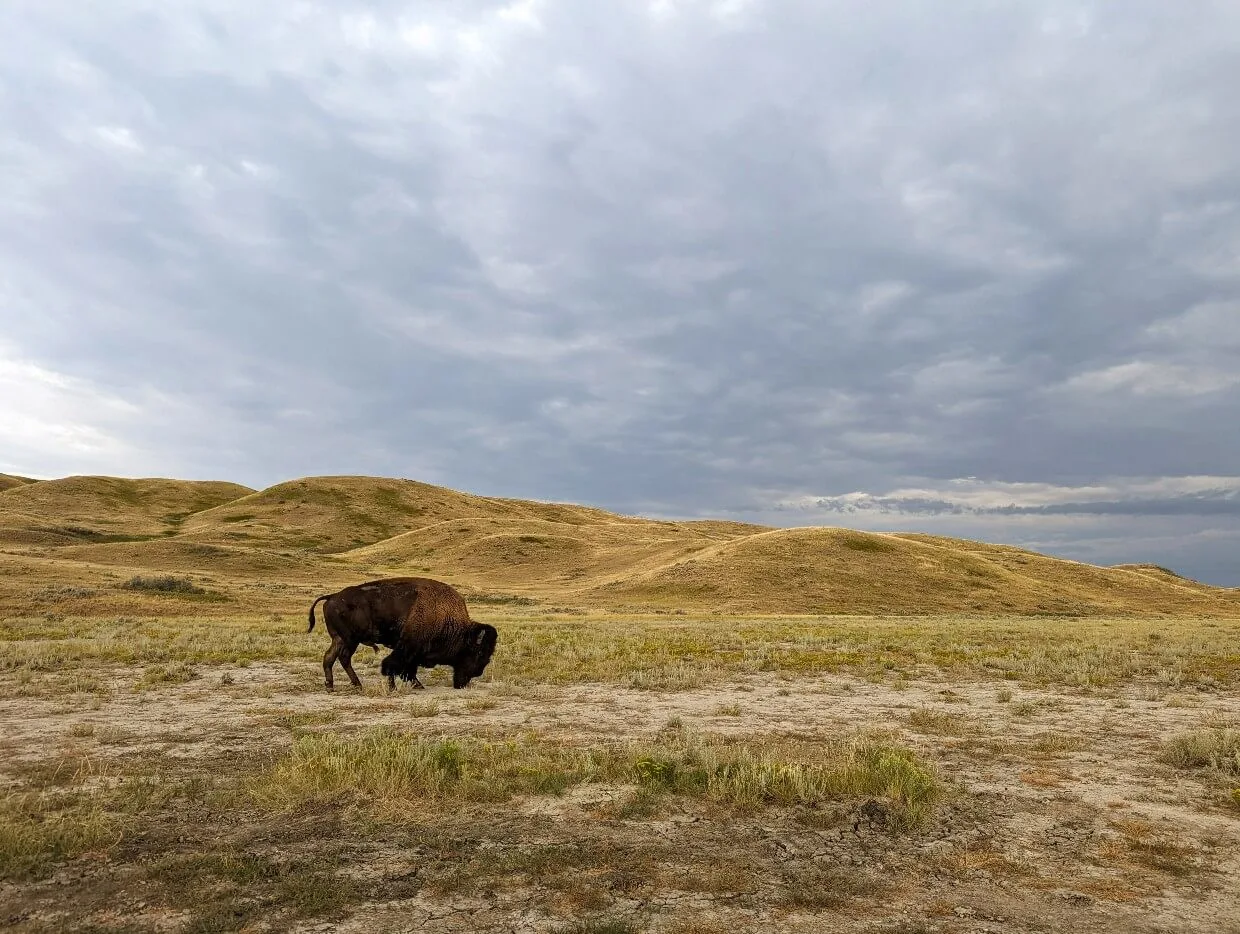
Here’s what to expect:
- An introduction to Grasslands National Park
- Top things to do in Grasslands National Park
- Grasslands National Park camping
- Where to stay close to Grasslands National Park
- Grasslands National Park FAQs
Last updated January 2024
We visited Grasslands National Park with the assistance of Tourism Saskatchewan.

Introducing Grasslands National Park
Grasslands National Park is one of Canada’s newest national parks, protecting a rare ecosystem of mixed grass prairie.
Indigenous people have lived and travelled in this area for more than 10,000 years, including the Gros Ventre, Assiniboine, Cree, Blackfoot, Sioux and Lakota. Tipi rings, arrowheads and other artifacts can still be found in the park.
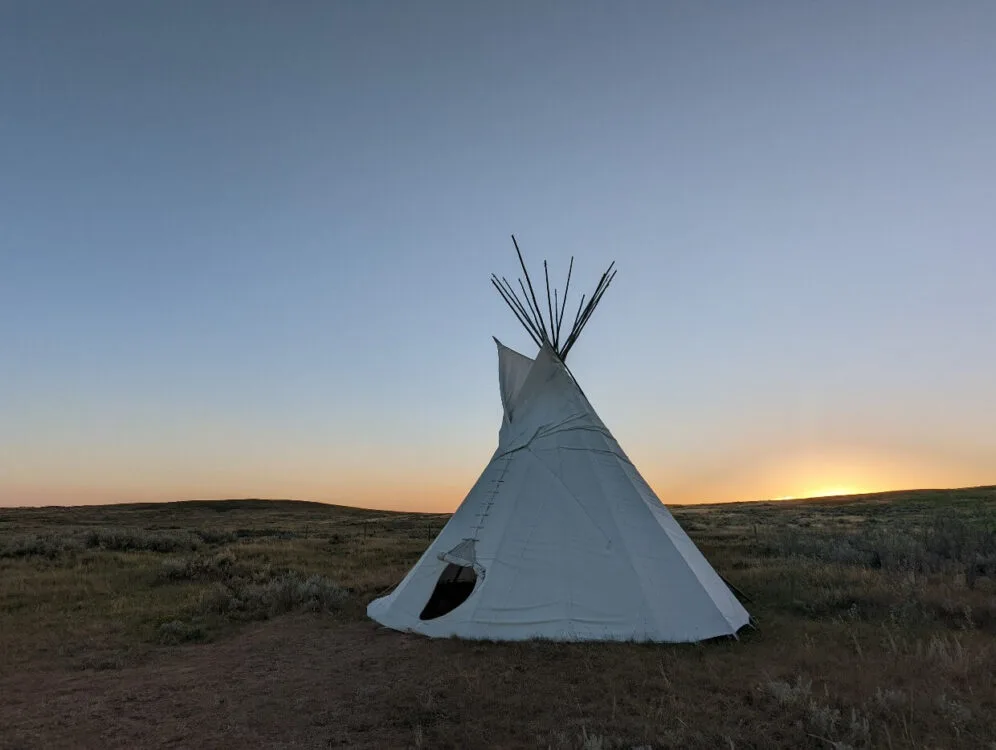
The Métis were known to hunt bison here, before the the large herds were driven to extinction by settlers. Ranchers then moved in and replaced the bison with free roaming cattle.
In 1908, farming took precedence over ranching. More than 70% of Canada’s grasslands have been since lost to agriculture, replaced with the grain fields that most associate with the prairies.
Conservation groups first promoted the idea of a protected area of grasslands in the 1950s. The idea finally came to fruition in 1981, when Canada and Saskatchewan signed an agreement to establish the park.
Grasslands National Park is now one of the largest undisturbed pockets of native prairie in North America.

Grasslands’ landscape is probably more complex than you may imagine. As well as rolling fields of grasses, there are eroded river valleys, steep canyons, hoodoos and buttes.
The park is split into two sections, each with a distinct personality.
The West Block is best known for wildlife watching opportunities and calming landscapes, while the East Block showcases dramatic badlands scenery. The latter also features a treasure trove of fossils, including dinosaur bones.
There are some affiliate links in this post. If you make a purchase/booking via one of these links, we may receive a small percentage of the sale at no extra cost to you.
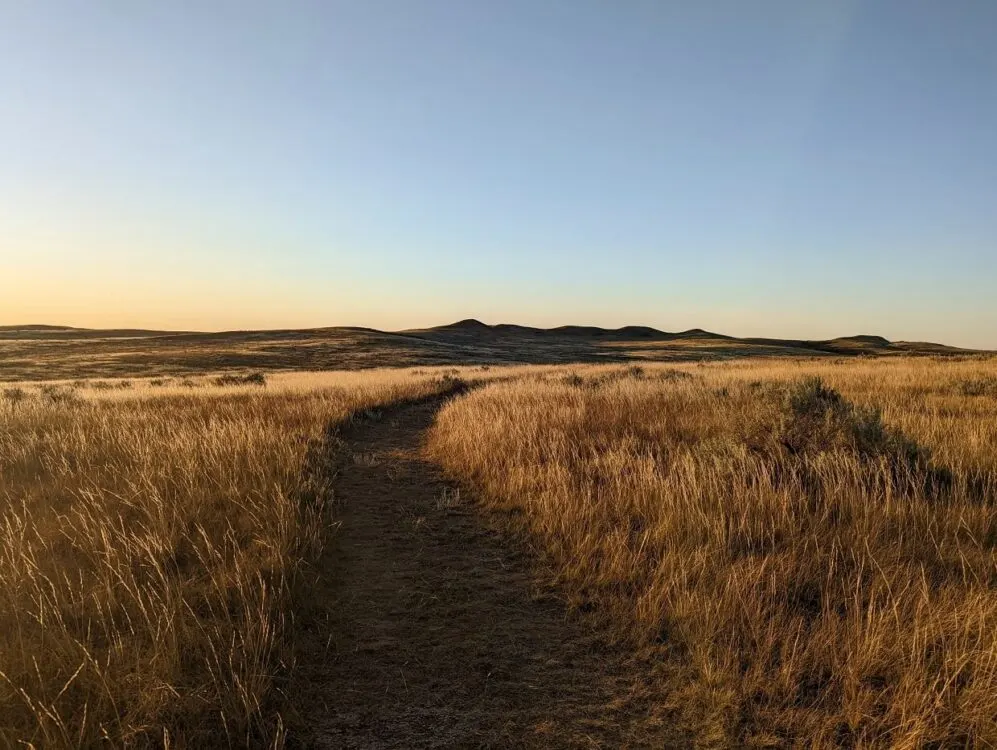
How to get to Grasslands National Park
Grasslands National Park is located in south Saskatchewan, Canada. The park is a minimum of a two hour drive from Highway 1 (from Swift Current).
Separated into two sections, it’s important to know which block you’re heading to when travelling to the park. The West and East Blocks (click for map) are located 160km apart (a two hour drive).
Parks Canada warns that GPS directions to Grasslands National Park are not always correct and we can definitely confirm that (at least for Google Maps).
Follow the directions on the Parks Canada website and look out for the green signage along the route.
The West Block is divided into three areas, all close to the village of Val Marie – Ecotour Road (main section, includes Frenchman Creek campground), 70 Mile Butte and Two Trees.
If visiting the West Block first, make a detour to the Visitor Centre in Val Marie for information and trail maps.
The East Block has just one entrance, approached via Highway 18. The Visitor Centre is situated next to Rock Creek Campground.
The drive between the two Blocks is straightforward and very well signed. Please note that there are no gas stations along the route.
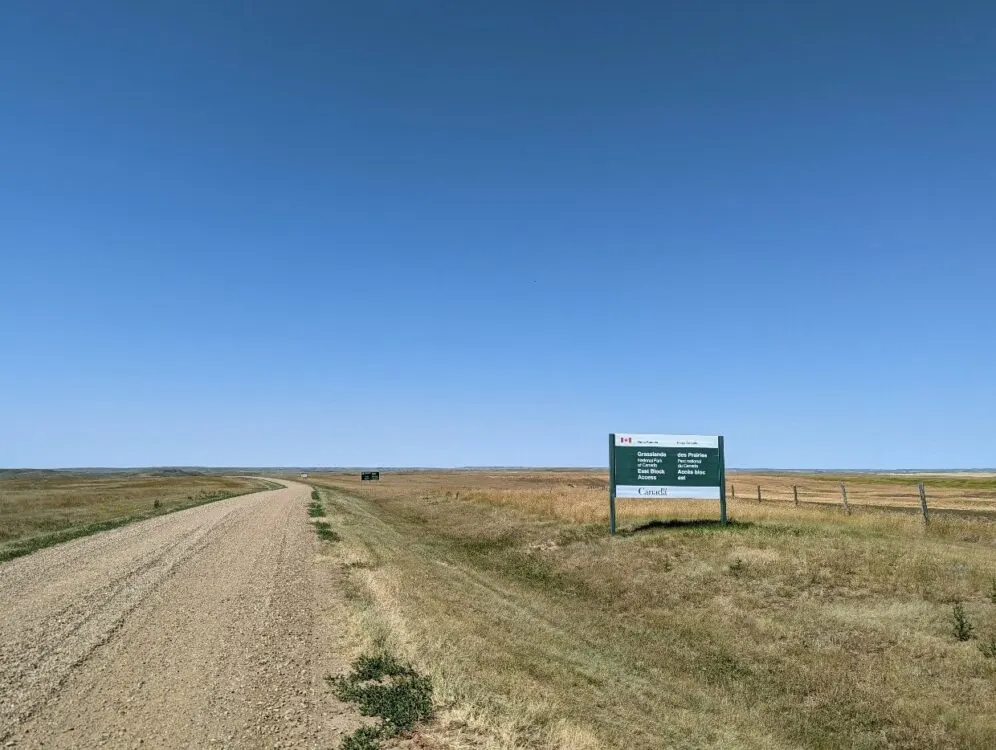
Planning a trip to Grasslands National Park
I would recommend spending at least two days in Grasslands National Park. With the drive between the Blocks being around two hours, it’s best to dedicate one day to each side.
If you can, stay longer. Wildlife spotting your priority? Spend an extra day or two exploring the West Block. Love fossils? Book yourself onto a Fossil Fever tour and spend an extra day in the East Block.
Adventurous hikers may want to spend 4 to 5 days in the park and explore some of the longer trails (15km Timbergulch loop or 12km Valley of 1000 Devils Route).

Here’s a few things you should know before travelling to Grasslands National Park:
- There is no phone signal in either the East Block or the West Block. Let someone know where you’re going and when you plan to be back
- Services are very limited – there are no hotels or shops within the park. Bring everything you need with you (and pack out everything afterwards!)
- Both West and East Blocks are accessible via gravel roads only. Check your tire pressure and spare tire before leaving and top up on gas. Be prepared to drive slower than you normally would
- There is a daily admission fee of $6.50/adult (2024). Children and youth (up to 18 years old) receive free entry. If you’re visiting other Canadian national parks, it may be worth buying a Discovery Pass
- Expect very hot temperatures in summer, with 28-35c being average. Thunderstorms are common. Evenings are cooler. Bring plenty of layers and sun protection (sun hat, sunscreen etc.)
- Don’t rush! Grasslands National Park is best enjoyed at a relaxed place. There’s no need to rush around here

Top things to do in Grasslands National Park
Here are the top 10 things to do in Grasslands National Parks, as tried and tested by us! Most activities listed here can be enjoyed in both Blocks.
A wonderful aspect of Grasslands is that you don’t have to be super active to enjoy the park. With two scenic drives, there’s plenty to see without going too far from your vehicle.
Of course, I’ll always advocate exploring as much as you can, but I appreciated this level of accessibility. There’s a lot of child friendly activities as well,.

Drive the Badlands Parkway (East Block)
The Badlands Parkway is the perfect introduction to Grasslands National Park. Curving along a ridge near the entrance to the East Block, this 11km paved road provides panoramic views of steep ravines and canyons with a backdrop of rolling hills.
There are six viewpoints located along the route, with interpretive signage and designated parking at each one. Our favourite was Ta Sunka Watogla, situated right at the end of the Parkway.

Stop as much and for as long as you want – there’s no need to feel hurried here. The road is one lane for most of the route, but there 20 passing places. The lack of trees makes it easy to spot approaching vehicles!
While taking in the spectacular views, be sure to watch for wildlife as well. We spotted a pronghorn antelope grazing by the side of the road.
Please note that there is designated parking for trailers at the entrance to the Badlands Parkway

Hike the trails
One of the best ways to connect with the prairie landscape is to go hiking. There are 13 designated hiking trails in the park, with most located within the West Block. Experienced hikers can also explore a handful of unmaintained hiking routes as well.
Grasslands’ hiking trails range from easy flat paths (3km or less) to challenging all day adventures (11-17km). There are guided hikes too (additional fee) – check at the respective Visitor Centre for details.

For a good overview of the park, I’d suggest:
- The Top Downtown Trail (West Block, 750m loop) – Level trail through prairie dog colony, with coulee views
- Rock Creek Trail (East Block, 2km loop) – Easy path with sweeping views of rolling grassland
- Two Trees Trail (West Block, 4km loop) – Short but steep trail with impressive vistas and vibrant wildflowers in summer
- Larson Trail (West Block, 1.5km loop) – Offers a chance to walk along the river and learn about the early ranching history of the area
If you have the time/energy/fitness/equipment to do it, check out the Valley of 1000 Devils Trail (East Block, 12km return). It features the best of the East Block’s badlands scenery, with huge hoodoos, ravines and canyons.
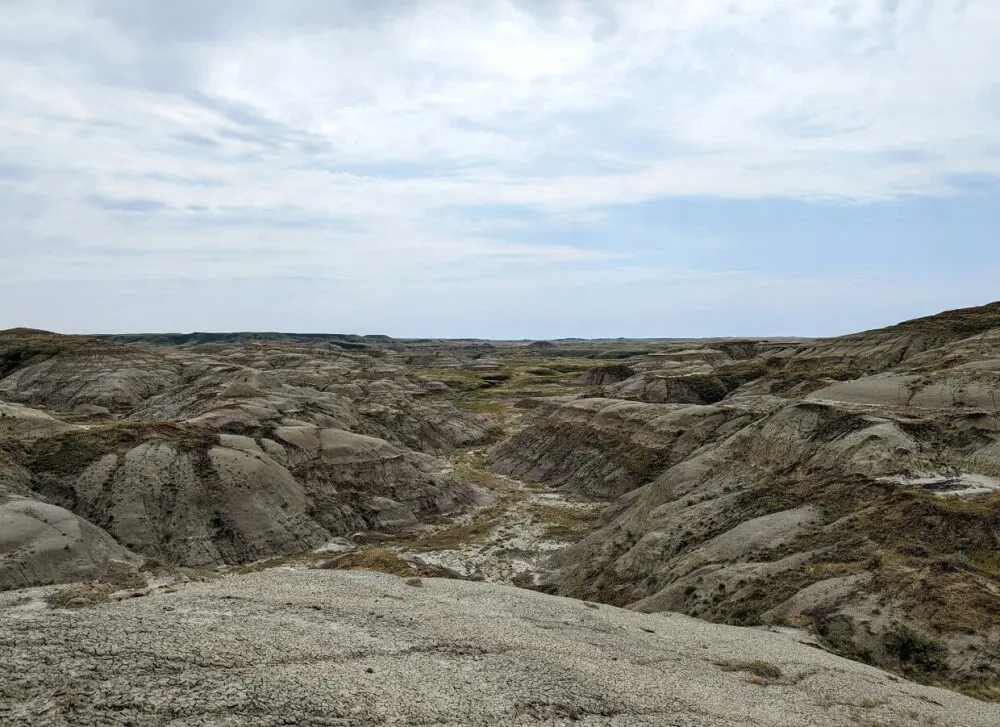
Follow the Ecotour Scenic Drive (West Block)
The Ecotour Scenic Drive is a must do while visiting Grasslands National Park. It travels 20km through the main section of the West Block, showcasing the sweeping prairie scenery and offering a chance to spot wildlife.
There are eight sightseeing stops on the route, some leading to hiking trails and historical sites. The Belza picnic area and Frenchman Creek Campground are located along the road as well.

On our own cruise of the Ecotour, we saw bison, badger, rattlesnake and coyote. We also had the chance to watch what felt like hundreds of cute prairie dogs. I loved watching them run between burrows and bark to each other.
Like most of the roads in Grasslands, the Ecotour is gravel. But having to go slow improves your chances to see wildlife!

Stay the night
To fully experience the wildness of Grasslands National Park, plan to stay the night. Each Block hosts one front country (vehicle accessible) campground, with opportunities for backcountry camping as well.
Don’t have a tent or RV? Rent one of Grasslands’ oTENTiks. Offering a stress free, super comfortable way to camp, oTENTiks are a cross between a tent and an A frame cabin.

Think waterproof canvas, wooden surrounds and a raised floor. Inside, there’s a set of table and chairs and a padded sleeping area.
There’s heating, lighting and electricity, with a fan for hot days as well. A barbeque and fire pit sit outside, along with another seating area. Campers just need to bring bedding, cooking equipment, food and a cool box.


Join a Fossil Fever tour (East Block)
Grasslands’ East Block was the site of the first dinosaur bone discovery in Canada. 66 million years ago, this area was a coastal forest with a warm, wet climate. Huge dinosaurs (including the T-rex) roamed the land.
Parks Canada’s Fossil Fever event, held over a five day period in August each year, provides the opportunity for visitors to learn more about this ancient time.
When we signed up to a tour, we figured that we may get a chance to hold a fossil or two, while watching the palaeontologists do their work at the active dig site.

I’ve never been happier to be wrong – the Fossil Fever tours are fully hands on, with a chance not only to hold 66 million year dinosaur bones but actually dig them out from the ground!
JR and I uncovered what the palaeontologists believe was a triceratops’ femur. We also found many, many other bone fragments. Other people on our tour found million year old fish scales, turtle shell and crocodile bone.
After a couple of hours at the dig, we joined a hike to see an exposed section of rock that displays the K–Pg boundary line that marks the mass extinction event that wiped out most of these dinosaurs (mind blowing!)
I was truly living my Jurassic Park dream that day and I would whole heartedly recommend the Fossil Fever to anyone with even a passing interest in fossils and dinosaurs. Be sure to reserve early!

Take in a sunset
The combination of such open landscapes and Saskatchewan’s living skies produces some truly spectacular sunsets in Grasslands National Park.
Visiting in early August, we watched as the sun spent hours slowly sinking behind the endless rolling hills. A golden glow stretched across the prairie, lighting up each individual blade of wind rippled grass.
While there were no clouds in the sky during the sunsets we witnessed, seeing the horizon light up in various shades of orange was still very special.
In the East Block, I’d recommend heading up to the Gateway to the Grasslands stop on the Badlands Parkway for sunset.

Watch wildlife
The seemingly dry prairie of Grasslands National Park is home to more animals than you may think. Some species are rare, and in a few cases, even endangered.
The Plains Bison is the largest resident of the park, re-introduced in 2005. A 300-400 strong herd now roams the West Block. These magnificent animals are symbolic of the prairies and their grazing helps to restore the natural ecosystem of the grasslands.

The West Block is also host to Canada’s only remaining black-tailed prairie dog colonies in Canada. Some of these colonies are visible right from the Ecotour Scenic Drive. Burrowing owls live in abandoned prairie dog burrow holes.
Keep your eyes peeled for pronghorns across the park, an antelope-like mammal with short, curved horns. Badgers and coyotes can also be spotted.
Hikers should watch their step for the prairie rattlesnake, the only venomous snake found in Saskatchewan. Luckily, the chance of being bitten is very low (you’re more likely to be hit by lightning).

Star gaze
View the night sky like never before in Grasslands National Park, which holds the title of Canada’s darkest Dark Sky Preserve.
The vast open prairie landscape is completely undisturbed by light pollution, revealing a star filled sky at night. Needless to say, it’s a mecca for star gazers and photographers.
If star gazing important to you, be sure to check the moon cycle before planning a visit to Grasslands. We visited during a full moon, so it was unfortunately too bright to see the stars.
The ‘Beyond the Big Dipper’ event, usually held four times during the summer, features a presentation by Royal Astronomical Society astronomers.

Find the red chairs
Parks Canada has placed more than 200 red Adirondack chairs in beautiful locations from coast to coast to coast. As well as offering a relaxing place to sit and take in the views, many people love to seek them out as part of a scavenger hunt.
There are seven sets of chairs in Grasslands National Park. Some are very easy to spot, while others require some beyond the beaten path exploration. We found four of the seven sets – three in the East Block and one in the West Block.
If you’d like to know exactly where to find Grasslands’ red chairs, head to this Parks Canada page. It lists the exact location with coordinates. Otherwise, keep it as a surprise and see how many you manage to find!

Go backpacking
Grasslands National Park offers backcountry enthusiasts with the ultimate gift of freedom – it is permitted to pitch a tent almost anywhere in the park. Yes, really!
Needless to say, Grasslands National Park is a pretty special backcountry camping destination. It’s already a quiet place to explore, but the backcountry is the true epitome of solitude.
Of course, there are some rules. Backcountry campers, for example, must not pitch a tent in view of roads and trails. Following Leave No Trace principles is mandatory.
Checking in at the Visitor Centre before heading out is absolutely essential, to get the latest information regarding conditions and pick up a backcountry camping permit.
Skip ahead to our backcountry camping section to learn more

Other amazing things to do in Grasslands National Park
- Geocaching: Hunt for some or all of the 11 geocaches hidden in the park (5 in the West, 6 in the East). GPS units are available for rent at the Visitor Centres
- Cycling: Explore the Ecotour Road or Badlands Parkway by bike. There are no bike specific trails in either block, but adventurous mountain bikers can ride the Valley of 1000 Devils Trail (East Block) or the Broken Hills Trail (West Block)
- Kayaking: Paddle the Frenchman River and take in the views from a different angle! Contact the West Block Visitor Centre for updated conditions first. Guided kayak tours are available with Carefree Adventures
- Horseback riding: Horses have been utilised to explore this landscape for centuries. Horse owners are welcome, with equestrian camping available in both park blocks. Local outfitters, such as Gold Willow Ranch, offer guided horseback rides
- Birdwatching: Common and rare birds can be spotted across the park, with plenty of seasonal variation. Endangered species living in this area include the burrowing owl and greater sage grouse
- Fireside chats: Join park interpreters for an evening of fun around the campfire, every Friday night from early May to early September

Grasslands National Park camping
There are two front country (vehicle accessible) campgrounds in Grasslands National Park – Frenchman Valley Campground in the West Block and Rock Creek Campground in the East Block.
Before getting into the details of each campground (as well as the backcountry camping options), here’s some things you should know:
- Frenchman Valley and Rock Creek campgrounds are both open from early May to mid October
- The access roads to Grasslands’ campgrounds are gravel only
- Campsites are suitable for RVs, vans and tents. In 2024, the campsite fee is $33/night
- All campsites have a fire pit and picnic table, as well as electricity
- Both campgrounds have outhouses (pit toilets) only – no flush toilets or showers
- There are no trees in the campgrounds and therefore no natural shade
- Potable water is available from late May to early September only
- RVs must fill up water tanks in advance – there are potable water tanks in each campground but only small drinking jugs may be used
- Dogs are allowed in the campgrounds but should be on a leash at all times and not left unattended
- Both campgrounds are 100% reservable. Reservations are highly recommended. Frenchman Valley does have an overflow area ($17.50night)
- The reservation system launch is usually in late January/early February each year (check dates)
- In 2024, the reservation launch date is 2nd February at 8am CT. On this date, availability opens for the entire camping season
- Camping is the only way to stay overnight in Grasslands National Park. If you don’t have a tent or RV, consider renting an oTENTik ($111.00/night)

Frenchman Valley Campground – West Block
Situated in the centre of the park’s West Block, Frenchman Valley Campground is set within an open prairie landscape and bordered by a hill on one side. It is accessible via the Ecotour Road.
The campground hosts 20 sites, with 3 pull through and 1 wheelchair accessible. There are 4 oTENTiks as well, each with incredible views of the prairie. FV24 has the most privacy, so reserve that one if you can!

The Coulee Centre is located next to the campground and includes a covered cooking area with wi-fi. A hiking trail leads behind the Coulee Centre up to the Belza picnic area.
Campers can check in at the West Block Visitor Centre in Val Marie (9am to 5pm) or the Frenchman Valley kiosk located in the Coulee Centre (2pm to 7pm).

Rock Creek Campground – East Block
Rock Creek Campground is located in the East Block, located on a slight rise and surrounded by rolling hills. The wide open views and the spacing of the sites make it my favourite campground of the two.
There are 24 campsites here, with 8 oTENTiks. If you’re planning to stay in the latter, I’d recommend booking RC25-28 as a priority. These have more privacy and have better views (especially at sunset).

Campers check-in at the East Block Visitor Centre, situated just down the hill from the campground (11am to 7pm). There is a day use picnic area here as well, with a dump tank for RVs.
Several hiking trails start close to the campground, including the Rock Creek Trail (easy), Creek to Peak Trail (easy) and the Valley of 1000 Devils Trail (challenging).
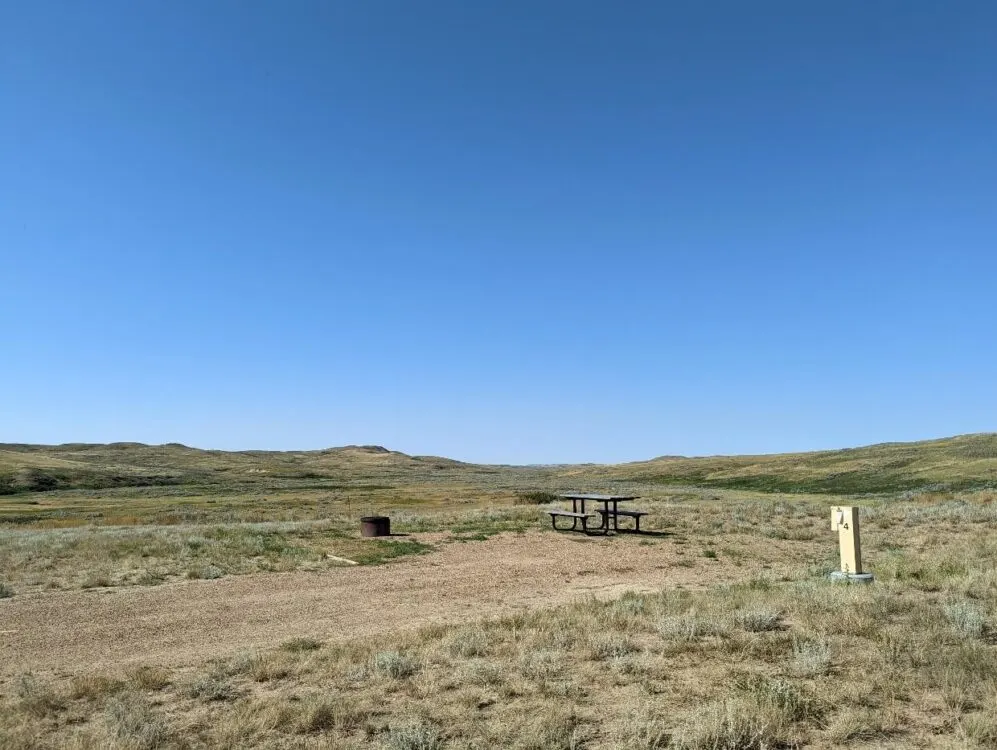
Backcountry camping
Backcountry camping in Grasslands National Park is a pretty unique experience in that visitors have the freedom to choose the perfect spot almost anywhere in the park.
Keep in mind that there are no designated backcountry campsites, so no facilities so campers must be careful to follow Leave No Trace principles.
Here are the other rules to follow:
- Prior to departure, register with staff at the nearest Visitor Centre and receive up to date safety and navigational information
- Park at designated trailhead for chosen backcountry zone
- Camp out of view of roads and trails, a minimum of 1km
- No campfires
- Dispose of human waste properly – dig a shallow hole 70m from trails, campsites and water sources. Cover with soil afterwards
- Pack out everything you bring with you, including used toilet paper, garbage and food waste
- Keep pets on a leash at all times
- Arrive and leave with clean clothing to prevent the spread of invasive plants
- Leave all natural and historical items objects where you find or see them
- Bring plenty of water
- Do not camp near prairie dog colonies and stay away from bison herds
The backcountry camping fee in Grasslands National Park is $10.50 per person.
Backcountry hikers are recommended to wear over-the-ankle footwear and trousers to protect against snake bites and spear grass.
New to backpacking? Start with our first timer’s guide and then check out this packing list post and safety guide

Essential camping items
Grasslands National Park is very dry and hot in summer. It can be windy too. With this in mind, consider bringing these items with you when camping in the park:
- Plenty of personal sun protection – Sun hat, sunscreen, sunglasses etc.
- Tarp – A lightweight tarp can be used to created shade. Keep in mind that there are no trees in the campground so you’ll need to use hiking poles or other items to put it up
- Small water jug – Plan to drink plenty of water. As well as drinking bottles, bring a larger water container for refills
- Lantern – Frenchman Creek Campground has lantern hangers. Here’s a lightweight, packable version
- Camp stove – Don’t rely on cooking food on a campfire – fire bans are relatively common in this area. Bring a portable camp stove
- Layers of clothing and a mix of bedding – Daytime temperatures can be very hot but the thermostat can really drop when the sun goes down. Bring some warmer clothing and bedding to combat the potential evening chill
Read Next: Car Camping 101: A Beginner’s Guide
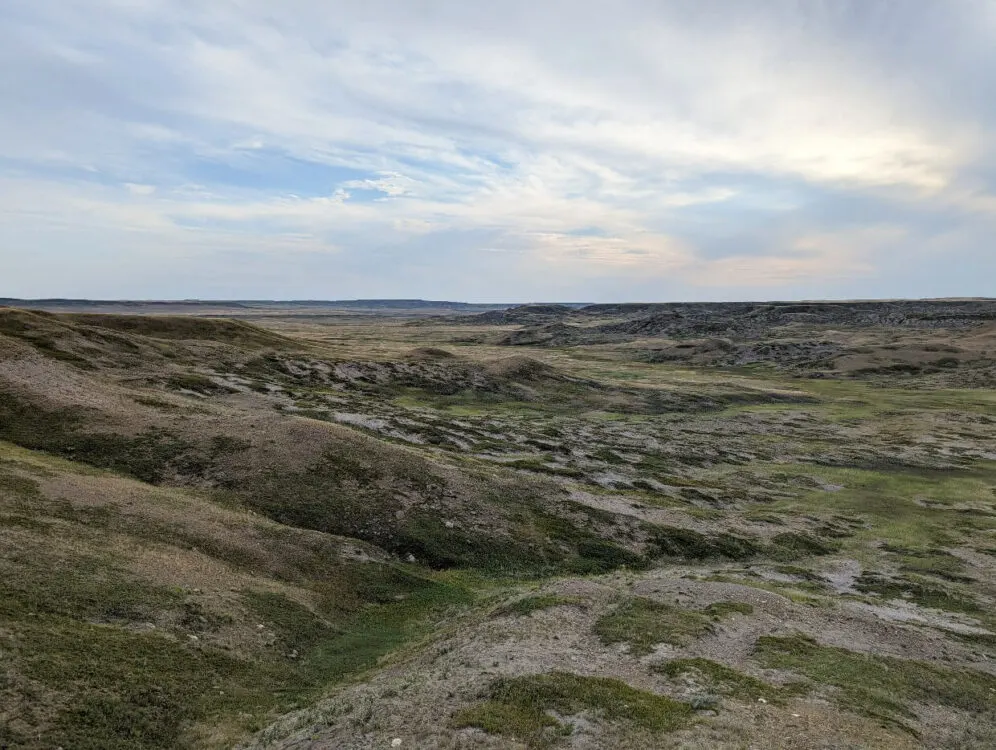
Where to stay close to Grasslands National Park
Camping is the only option to stay overnight within the national park itself. Here are the options for nearby accommodation.
Val Marie (West Block)
With a choice of B&Bs and vacation rentals, Val Marie provides a good base forvisitors not keen on camping.
This small village is within easy driving distance (20 minutes or less) from all three West Block entrances.
Val Marie has a gas station, grocery/liquor store (closed Sunday) and restaurant (closed Monday). The West Block Visitor Centre is also located right in the village.
Accommodation options include:
- The Convent Inn – Abandoned convent building converted into a nine bedroom inn. Multiple room configurations, all with shared bathrooms. Breakfast is included with every stay
- The Sanctuary Inn – Two self contained suites located in the former former Grace United Church, each with air conditioning and kitchenettes
- The Crossing at Grasslands – Three self contained suites 5km south of Val Marie, right on the border of Grasslands National Park. Kitchen facilities and great views. Labyrinth path located on the property
- Sky Story – Beautifully decorated B&B rooms owned by professional visual artist. Studio tour and yoga consultations available, as well as guided indigenous cultural experiences
- Don’s Place – One, two and three bedroom suites with kitchen facilities (or access to shared facilities) close to Grasslands National Park

Rockglen (East Block)
Nearby accommodation is very limited around Grasslands’ East Block, with one of the nearest options being the Rockglen Motel (45 minutes drive).
The community of Rockglen has a grocery store, gas station, café, visitor centre and campground.
Swift Current, Moose Jaw and Regina
Grasslands National Park may feel remote, but the West Block is just 90 minutes drive from Highway 1 and Swift Current.
The East Block is a little further, being two hours and 30 minutes south of Moose Jaw.
Both cities are viable options for accommodation, with a range of hotels, motels, B&Bs and vacation rentals available.


The night before travelling to the East Block, we stayed in Regina at the beautiful Hotel Saskatchewan. The drive to the park took 3.5 hours.
There are very few towns between Regina and the East Block so if you make the same journey, make sure to stock up with supplies before leaving. For the most impressive picnic lunch around, head to Takeaway Gourmet.


Grasslands National Park FAQs
To finish, I’ll answer some of the most frequently asked questions about Grasslands National Park.
Where is Grasslands National Park?
Grasslands National Park is situated in southern Saskatchewan, just above the border with Montana.
The park is divided into two sections – the West Block and the East Block. Allow two hours to drive the 160km distance between the two sides. Orient yourself with this Parks Canada map.

When was Grasslands National Park established?
Grasslands National Park is a relatively new entity, being established as a Canadian national park on February 19th 2001. It was the result of a 50 year campaign by conservationists.
The original intention was to create a 900 sq. kilometer park, of which Parks Canada has acquired 80% so far. The remainder of the land will be purchased if and when the land owners want to sell.
What is Grasslands National Park known for?
Officially, Grasslands National Park was established to ‘preserve and present a representative portion of the Canadian mixed grass prairie ecosystem’ (Parks Canada).
The park offers the chance for visitors to view a rare Canadian landscape, explore hiking trails, cruise scenic drives, spot rare wildlife (bison, prairie dogs, pronghorn antelope and more), camp under the country’s starriest skies and learn about paleontology, indigenous connections and homesteading.

East Block vs. West Block – which side of Grasslands National Park is better?
The East and West Blocks are both well worth exploring, for different reasons. I highly recommend visiting both sides of the park if you can.
The East Block features a dramatic badlands landscape featuring steep ravines and hoodoos. It’s also a hotspot for fossils.
The landscape of the West Block is more calming than dramatic, showcasing prairie grasslands with rolling hills all the way to the horizon. A river runs through the middle. The West Block is best for wildlife viewing, particularly prairie dogs and bison.
Do you need a park pass to visit Grasslands National Park?
Yes, there is a daily admission fee to visit Grasslands National Park. The 2022 price is $6.25 for adults and $5.25 for seniors. Visitors aged 17 or under receive free entry. Discovery Pass holders also receive free entry.

When is Grasslands National Park open?
Grasslands National Park is open all year round. Services are available from early May to mid October only (Visitor Centers, washroom facilities, road clearing, trail maintenance etc.)
Can you see wild bison in Grasslands National Park?
Yes! Though it’s not guaranteed, there is a chance to see wild roaming bison while visiting Grasslands National Park, specifically in the West Block.
Plains bison were reintroduced to the park in 2005. Hunted to near extinction in the 1880s, millions of bison once roamed in this area.
The initial herd released into the West Block consisted of 71 bison. The population is estimated to be 400-500 today.
Wildlife are not predictable, but driving the Ecotour Road offers a good possibility to see bison. Keep your eyes peeled for the length of the route, especially around the watering hole (2.2km from the park entrance, watch the live webcam here).
If you do see bison, keep your distance. Stay at least 100 metres away and always leave them an escape route.
Where is the best place to stay in Grasslands National Park?
Grasslands National Park is a wilderness park, with on-site accommodation limited to rustic campgrounds only (more details in the camping section).
If you don’t have a tent, I’d highly recommend renting one of Parks Canada’s oTENTiks. A mix of a tent and A frame cabin, these sleep up to six people (bring your own bedding). There are 8 oTENTiks situated in the East Block and 4 in the West Block.

Other posts you may enjoy:
Quetico Provincial Park, Ontario: Complete Canoe Paddling Guide
15+ Fun Things to Do in Calgary For Adults
Highway 17 Road Trip: 10 of the Best Ontario Parks
Lake O’Hara Hiking and Camping 2022 Guide, Yoho National Park
East Coast Canada Road Trip | 2 and 4 Week Itineraries
Adventure in your inbox
Subscribe to our monthly email newsletter and receive a round-up of our latest outdoor adventures plus other exciting beyond the beaten path destinations
We never share your information with third parties and will protect it in accordance with our Privacy Policy

One half of the Canadian/British couple behind Off Track Travel, Gemma is happiest when hiking on the trail or planning the next big travel adventure. JR and Gemma are currently based in the beautiful Okanagan Valley, British Columbia, Canada
